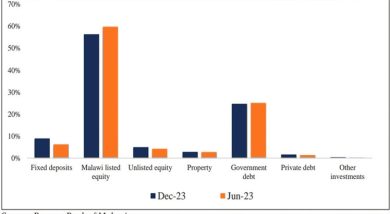Malawi inflation rate rises to 12.4%
 Malawi’s April inflation rate surged to 12.4 percent from 11.4 percent in March, driven by a rise in non-food items, the National Statistical Office (NSO) has said.
Malawi’s April inflation rate surged to 12.4 percent from 11.4 percent in March, driven by a rise in non-food items, the National Statistical Office (NSO) has said.
This is the fourth month in which the rate has been in double digit territory, perched there in January this year for the first time in three years.
The inflation monster, which economists agree hurts the poor most, is pushing the cost of living to unsustainable levels and threatening to shove more Malawians into the extreme poverty trap in which earnings are less than $0.30 (K75 at the current exchange rate).
The April inflation rate rise has come at a time when major developments in the economy—notably the 49 percent devaluation of the kwacha by the Reserve Bank of Malawi (RBM) effected on May 7, a 63 percent rise in fuel prices, three percentage points increase in bank rate to 16 percent from 13 percent and an average 63.3 percent rise in electricity—have not kicked in.
Effectively, this means that most of the cost push effects of the development will be felt much more when the May figures are released in mid June.
The evidence of further erosion in purchasing power could make the fight against poverty, the centre-piece of the Malawi Growth and Development Strategy (MGDSII), much harder than it already is.
Local economic justice lobby group, the Malawi Economic Justice Network (Mejn) executive director Dalitso Kubalasa told Business News yesterday that the inflation rate rise shows how difficult times are and will be in the foreseeable future as the Malawi economy sets on the recovery path.
“This clearly shows the direction our economy took in the recent past. This is a clear manifestation of how bad things have been…it is going to be tough going forward,” said Kubalasa.
He stressed that there is need to carefully relook the road map and benchmarks set in the MGDS to avoid nasty surprises during implementation.
Government has this year revised downwards its gross domestic product (GDP) growth projection to 4.3 percent from six percent as earlier estimated.
Finance Minister Dr Ken Lipenga last week projected an inflation rate for 2012 of 15 percent, beating by a wide margin the 2011/12 budgeted figure of 6.9 percent. This has raised fears of continued rise in the prices of goods and services.
He said in 2011, inflation edged up to 10.2 percent against the government’s target of seven percent.
The rate at which inflation is rising will also throw into disarray authorities’ projections of the decline in the price rise to 5.9 percent from 8.7 percent from 2011 to 2014 as targeted in the second generation MGDS.
Even with the surplus of the staple grain, which, as part of the food component accounts for 58.1 percent of the Consumer Price Index (CPI)—a measure that examines the weighted average of prices of a basket of consumer goods and services—the inflation rate has continued to climb.
The NSO’s Stats Flash, released yesterday, said: “Although prices of the staple grain have declined during this period, prices of processed foods and non-food items continue to rise giving an upward push to headline inflation.”
This means that despite Malawi’s inflation being heavily dictated by food, non-food inflation which forms part of the core inflation—a measure of inflation which excludes certain items that face volatile price movements, notably food and energy—will exert much pressure on price rises.
The NSO reports that food inflation is just above three percent whereas non-food inflation is nearing 12 percent.
In the 2011/2012 crop season, Malawi is expected to produce 3.6 million tonnes of maize, a seven percent drop from the previous year’s production, but which still leaves a surplus of 566 552 tonnes.
The NSO said both the urban and rural inflation went up to 15.5 percent and 10.7 percent from 14.9 percent and 9.5 percent, respectively.
The rise in inflation has proved true analysts’ predictions with investment and advisory firm Nico Asset Managers projecting a further rise in prices, resulting in lower disposable incomes and reduced savings.
The influential British economic think-tank, the Economist Intelligence Unit (EIU), before the devaluation, put Malawi’s inflation at 12.5 percent in 2012 due to increases in international oil prices, among others.





